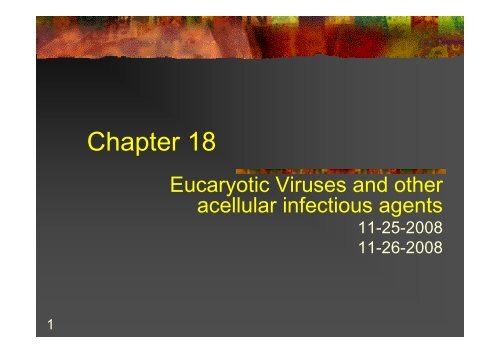Chapter 18
Chapter 18
Chapter 18
You also want an ePaper? Increase the reach of your titles
YUMPU automatically turns print PDFs into web optimized ePapers that Google loves.
<strong>Chapter</strong> <strong>18</strong><br />
Eucaryotic Viruses and other<br />
acellular infectious agents<br />
11-25-2008<br />
11-26-2008<br />
1
Taxonomy of Eucaryotic Viruses<br />
• most of the ~5,000 known viruses infect<br />
eucaryotic organisms<br />
• Virus classification by the ICTV<br />
• Genome structure<br />
• Replication strategy<br />
• Morphology<br />
• Genetic relatedness<br />
Copyright © The<br />
McGraw-Hill<br />
Companies, Inc.<br />
Permission required<br />
for reproduction or<br />
display 2
Viruses that Infect Vertebrates<br />
Figure <strong>18</strong>.1<br />
Copyright © The<br />
McGraw-Hill<br />
Companies, Inc.<br />
Permission required<br />
for reproduction or<br />
display 3
Reproduction of Animal Viruses<br />
• adsorption<br />
• penetration and uncoating<br />
• replication of virus nucleic acids<br />
• synthesis and assembly of virions<br />
• virion release<br />
Copyright © The<br />
McGraw-Hill<br />
Companies, Inc.<br />
Permission required<br />
for reproduction or<br />
display 4
Table <strong>18</strong>.1<br />
Copyright © The<br />
McGraw-Hill<br />
Companies, Inc.<br />
Permission required<br />
for reproduction or<br />
display 5
Penetration and Uncoating<br />
• fusion of envelope with host cell<br />
membrane<br />
Fig <strong>18</strong>.4<br />
Copyright © The<br />
McGraw-Hill<br />
Companies, Inc.<br />
Permission required<br />
for reproduction or<br />
display 6
Endocytosis – enveloped virus<br />
Figure <strong>18</strong>.4 (b)<br />
Copyright © The<br />
McGraw-Hill<br />
Companies, Inc.<br />
Permission required<br />
for reproduction or<br />
display 7
Endocytosis – naked virus<br />
Figure <strong>18</strong>.4 (c)<br />
Copyright © The<br />
McGraw-Hill<br />
Companies, Inc.<br />
Permission required<br />
for reproduction or<br />
display 8
Replication and transcription in DNA Viruses<br />
- Herpes simplex virus I<br />
uses host RNA<br />
polymerase for<br />
synthesis of viral<br />
mRNA<br />
uses virusencoded<br />
DNA<br />
polymerase for<br />
genome replication<br />
Figure <strong>18</strong>.6<br />
Copyright © The<br />
McGraw-Hill<br />
Companies, Inc.<br />
Permission required<br />
for reproduction or<br />
display 9
Poxviruses<br />
• large, morphologically complex doublestranded<br />
DNA (dsDNA) viruses<br />
• virion carries DNA-dependent RNA<br />
polymerase that synthesizes early<br />
mRNA<br />
• encodes DNA polymerase and other<br />
enzymes needed for DNA replication<br />
Copyright © The<br />
McGraw-Hill<br />
Companies, Inc.<br />
Permission required<br />
for reproduction or<br />
display 10
Hepadnaviruses- HBV<br />
• circular, partial dsDNA genome<br />
• transcribed by host RNAP<br />
• generates several mRNA molecules<br />
• one for pregenome RNA<br />
• others encode polymerase with reverse<br />
transcriptase activity<br />
• pregenome converted to dsDNA by virus polymerase<br />
(+RNA -DNA 2S DNA)<br />
11
Replication and Transcription<br />
in RNA Viruses<br />
• very diverse reproductive strategies<br />
• four general modes of replication and<br />
transcription<br />
12
Pico-RNA<br />
Para- and ortho-<br />
Myxo- affinity to mucin<br />
Respiratory-enteric-orphan<br />
Figure <strong>18</strong>.8<br />
Copyright © The<br />
McGraw-Hill<br />
Companies, Inc.<br />
Permission required<br />
for reproduction or<br />
display 13
Assembly of Virus Capsids<br />
• late genes direct capsid protein<br />
synthesis which spontaneously selfassemble<br />
to form the capsid<br />
• during icosahedral virus assembly<br />
empty procapsids form first, nucleic acid<br />
are then inserted<br />
• assembly of envelope viruses<br />
• in most cases, similar to assembly of<br />
naked viruses<br />
Copyright © The<br />
McGraw-Hill<br />
Companies, Inc.<br />
Permission required<br />
for reproduction or<br />
display 14<br />
• site of morphogenesis varies
Figure <strong>18</strong>.2<br />
Copyright © The<br />
McGraw-Hill<br />
Companies, Inc.<br />
Permission required<br />
for reproduction or<br />
display 15
Virion Release<br />
• naked viruses<br />
• usually by lysis of host cell<br />
• envelope viruses<br />
• formation of envelope and release usually<br />
occur concurrently (budding)<br />
• virus-encoded proteins incorporated into host<br />
membrane<br />
• nucleocapsid buds outward and is surrounded<br />
by modified host membrane<br />
Copyright © The<br />
McGraw-Hill<br />
Companies, Inc.<br />
Permission required<br />
for reproduction or<br />
display 16
Release of influenza virus by budding<br />
Figure <strong>18</strong>.11<br />
Copyright © The<br />
McGraw-Hill<br />
Companies, Inc.<br />
Permission required<br />
for reproduction or<br />
display 17
HIV release<br />
by budding<br />
Figure <strong>18</strong>.12 (a)<br />
Copyright © The<br />
McGraw-Hill<br />
Companies, Inc.<br />
Permission required<br />
for reproduction or<br />
display <strong>18</strong>
Mechanisms of host cell damage<br />
and cell death<br />
• inhibition of host DNA, RNA, and protein<br />
synthesis<br />
• lysosome damage<br />
• causes release of hydrolytic enzymes<br />
• alteration of plasma membrane<br />
• lead to attack of host by immune system<br />
• lead to cell fusion, forming syncytium<br />
Copyright © The<br />
McGraw-Hill<br />
Companies, Inc.<br />
Permission required<br />
for reproduction or<br />
display 19
Other mechanisms…<br />
• toxicity from high concentrations of viral<br />
proteins<br />
• formation of inclusion bodies<br />
• can disrupt cell structure<br />
• the Negri bodies in rabies infected neurons<br />
• chromosomal disruptions<br />
• transform host cell into malignancy<br />
Copyright © The<br />
McGraw-Hill<br />
Companies, Inc.<br />
Permission required<br />
for reproduction or<br />
display 20
Types of viral infections (Fig. <strong>18</strong>.3)<br />
• acute infections<br />
• rapid onset and relatively short duration<br />
• persistent infections- last many years<br />
• Chronic infection, e.g, HBV infection<br />
• Latent infection, e.g., Herpes virus infection<br />
-<br />
21
Types of persistent infections<br />
• chronic virus infection<br />
• virus almost always detectable<br />
• clinical symptoms mild or absent for long<br />
periods<br />
• latent virus infection<br />
• virus stops reproducing and remains<br />
dormant for some time<br />
• during latency, symptoms, antivirusantibodies,<br />
and viruses are not detectable<br />
Copyright © The<br />
McGraw-Hill<br />
Companies, Inc.<br />
Permission required<br />
for reproduction or<br />
display 22
Possible causes of persistent<br />
infections<br />
• integration of viral genome into host<br />
genome<br />
• decrease in antigenicity of virus<br />
• mutation to less virulent and slower<br />
reproducing form<br />
• defective interfering (DI) particle – deletion<br />
mutant that cannot reproduce and slows<br />
reproduction of normal virus<br />
Copyright © The<br />
McGraw-Hill<br />
Companies, Inc.<br />
Permission required<br />
for reproduction or<br />
display 23
Slow virus diseases<br />
• Symptoms take years to emerge<br />
• subacute sclerosing panencephalitis caused<br />
by measles virus<br />
• HIV infections<br />
• Prion<br />
Copyright © The<br />
McGraw-Hill<br />
Companies, Inc.<br />
Permission required<br />
for reproduction or<br />
display 24
Prion<br />
• A small proteinaceous infectious<br />
particle<br />
• Passes through the filter (100 nm)<br />
and still transmits disease<br />
• resistant to a wide range of<br />
chemical and physical treatment<br />
• inactivated at 121 o C 1 h
Prion-caused degenerative diseases<br />
• Scrapie<br />
• bovine spongiform<br />
encephalopathy (BSE) or<br />
mad cow disease<br />
• Creutzfeldt-Jakob<br />
disease (CJD) and<br />
variant CJD (vCJD)<br />
• Kuru<br />
Scrapie- cause intense itching<br />
- The prototype of prion<br />
- A natural progressive brain disease<br />
Copyright © The<br />
McGraw-Hill<br />
Companies, Inc.<br />
Permission required<br />
for reproduction or<br />
display 26
Kuru- “shivering” or “ trembling”<br />
• 1950, occurred in the Fore<br />
tribe of New Guinea<br />
highlands<br />
• Related to the cannibalistic<br />
practices<br />
• Blurred speech, silly smiles,<br />
and dementia<br />
lose the ability to walk, talk, and see
The 1 st<br />
Nobel Prize for prion study<br />
• 1976, Carleton Gajdusek (1923~)<br />
• retired as chief of the laboratory of CNS at NIH<br />
• Demonstrated Kuru’s etiology<br />
• an infectious invisible slow<br />
(~ 30 y incubation period) virus as<br />
that of Scrapie?<br />
• Never saw any inflammation!
Creutzfeldt-Jakob disease (CJD)<br />
• The human form of mad cow disease<br />
• BSE (Bovine Spongiform encephalopathy)<br />
• Identified by Creutzfeldt and Jakob (1920)<br />
• A progressive fatal neurodegenerative<br />
disease<br />
• Usually aged between 50~75<br />
• Characterized by seizures, massive incoordination,<br />
dementia
Transmission of CJD<br />
• Injection with contaminated growth hormone<br />
• Transplantation of contaminated corneas<br />
• Contact with contaminated medical devices<br />
• brain electrodes- “Iatrogenic”<br />
• Ingestion of infected tissue<br />
• 1996 in UK, causes an unusual incidence of CJD in<br />
young people (
Inheritable CJD- prnp<br />
• A Gerstmann-Straussier-Scheinker syndrome<br />
• A Kuru like familial disease Inherited forms<br />
emerge earlier (~ 45 yr)<br />
• familial CJD, GSS, fatal familial insomnia (FFI)-<br />
10~15%<br />
• specific mutation of the gene on chromosome 20-<br />
prnp
Current Model<br />
of Disease Production by Prions<br />
• PrP C (prion protein): “normal” form<br />
• PrP Sc : abnormal form<br />
• entry of PrP Sc into animal brain causes<br />
PrP C to change its conformation to<br />
abnormal form<br />
• the newly produced PrP Sc convert more to<br />
the abnormal form<br />
• interactions between PrP Sc and PrP C <br />
crosslinking of PrP C neuron loss<br />
Copyright © The<br />
McGraw-Hill<br />
Companies, Inc.<br />
Permission required<br />
for reproduction or<br />
display 32
The 2 nd Nobel prize-<br />
Prion pathogenesis<br />
• PrP sc binds to the normal PrP c<br />
on the cell surface, causing it to<br />
be processed into PrP sc - a<br />
replicating protein, to be<br />
released from the cell, and to<br />
be aggregated as amyloid-like<br />
plaques in the brain<br />
• Vacuolated neurons (loss of<br />
function and lack of an immune<br />
response)<br />
• 1997, Stanley Prusiner<br />
(1942~) for showing that<br />
PrP sc is sufficient to<br />
cause disease<br />
• Director of institute of<br />
neurodegenerative disease<br />
UCSF
Viruses and Cancer<br />
• tumor<br />
• growth or lump of tissue<br />
• neoplasia<br />
• abnormal new cell growth and reproduction due to<br />
loss of regulation<br />
• anaplasia<br />
• reversion to a more primitive or less differentiated<br />
state<br />
• metastasis<br />
Copyright © The<br />
McGraw-Hill<br />
Companies, Inc.<br />
Permission required<br />
for reproduction or<br />
display 34<br />
• spread of cancerous cells throughout body
Carcinogenesis<br />
• complex, multistep process<br />
• often involves oncogenes<br />
• cancer-causing genes<br />
• many involved in regulation of cell growth and<br />
differentiation<br />
• some viruses contribute to carcinogenesis<br />
Copyright © The<br />
McGraw-Hill<br />
Companies, Inc.<br />
Permission required<br />
for reproduction or<br />
display 35
Viruses implicated in human<br />
cancers<br />
Epstein-Barr virus<br />
Hepatitis B virus<br />
Hepatitis C virus<br />
Burkitt’s lymphoma<br />
nasopharyngeal<br />
carcinoma<br />
liver cancer hepatoma<br />
liver cancer<br />
Human herpesvirus 8<br />
HIV<br />
human papillomavirus<br />
HTLV-1 and HTLV-2<br />
Kaposi’s sarcoma<br />
cervical cancer<br />
Copyright © The<br />
McGraw-Hill<br />
Companies, Inc.<br />
Permission required<br />
leukemia<br />
for reproduction or<br />
display 36
Possible mechanisms by which<br />
viruses cause cancer<br />
• carry oncogene into cell and insert it<br />
into host genome<br />
• altered cell regulation due to changes in<br />
kinase activity or production of<br />
regulatory proteins<br />
• insertion of promoter or enhancer next<br />
to cellular oncogene<br />
Copyright © The<br />
McGraw-Hill<br />
Companies, Inc.<br />
Permission required<br />
for reproduction or<br />
display 37
<strong>Chapter</strong> 37<br />
Human Diseases Caused by<br />
Viruses<br />
38
Airborne Diseases<br />
• when human is source, airborne viruses<br />
are propelled from respiratory tract by<br />
coughing, sneezing, or vocalizing<br />
39
Chickenpox (Varicella)<br />
• caused by varicella-zoster virus<br />
• results from initial infection<br />
• Attenuated vaccine<br />
40<br />
Figure 37.1
Shingles (herpes zoster)<br />
• postherpetic neuralgia<br />
• reactivated form of chickenpox<br />
Figure 37.2
Flu or common cold<br />
• clinical manifestations<br />
• chills, fever, headache, malaise, and general<br />
muscular aches and pains<br />
• recovery usually within 3 to 7 days<br />
• often leads to secondary infections by bacteria<br />
• rhinitis, tonsillitis, laryngitis, bronchitis, and<br />
pneumonia<br />
• treatment, prevention, and control<br />
• symptomatic/supportive therapy<br />
• inactivated virus vaccine<br />
42
43<br />
Influenza (Flu) by influenza virus<br />
• Orthomyxovirus (segmented virus)<br />
• Classified into A, B, and C groups<br />
• 16 HA and 9 NA<br />
• Influenza Pandemics<br />
• 19<strong>18</strong>, HswN1 (Spanish flu)<br />
• 50~ 100 million moratlity<br />
• 1947, H1N1<br />
• 1957, H2N2 (Asian flu)<br />
• 1968, H3N2 (Hong Kong flu)<br />
• 1977, H1N1 (Russian flu)<br />
• Avian flu- H5N1(1997~)
Generation of a reassortant virus<br />
- broad host range and segmented genome<br />
Reassortant virus
Avian flu virus<br />
• H9N2 (1998/1999)<br />
• China and Hong Kong<br />
• H7N7 (2003)<br />
• Netherlands<br />
• H5N1 in human<br />
(1997~2003~)<br />
• Hong Kong, China, and<br />
worldwide….<br />
• since 2003, > 300<br />
infected and > 150 died<br />
Emerging Infectious Diseases (2007) October
SARS (Severe Acute Respiratory Syndrome)<br />
• An emerging disease cause by coronavirus<br />
• Flu-like syndrome<br />
• Vaccine target?<br />
- Virus of the year (2002-2003)<br />
Where is the SARS virus??<br />
Box<strong>18</strong>.1<br />
- a mutation in spike protein<br />
46
Classification of coronaviruses<br />
• 3 groups coronaviruses:<br />
• groups 1 and 2: mammalian viruses<br />
• group 3 contains only avian viruses<br />
• Classified into distinct species by host<br />
range, antigenic relationships, and<br />
genomic organization<br />
47
Phylogenetic analyses of SARS-CoV sequences<br />
48
Measles (Rubeola)<br />
• caused by measles virus<br />
• subacute sclerosing<br />
panencephalitis<br />
• rare progressive degeneration of<br />
central nervous system caused<br />
by measles virus<br />
• treatment, prevention, and<br />
control<br />
• symptomatic/supportive therapy<br />
• attenuated measles vaccine<br />
• MMR vaccine (measles,<br />
mumps, rubella)<br />
Figure 37.3<br />
49
Mumps<br />
• caused by mumps virus<br />
• pleomorphic, enveloped<br />
virus<br />
• helical nucleocapsid<br />
• negative strand RNA<br />
Figure 37.4<br />
50
Rubella (German Measles)<br />
• caused by rubella virus<br />
• ssRNA virus<br />
• spread by respiratory droplets<br />
• congenital rubella syndrome<br />
• infection of pregnant women in<br />
first trimester<br />
• fetal death, premature delivery,<br />
and/or congenital defects<br />
• live attenuated vaccine:<br />
MMR- measles, mumps, rubella<br />
51
Human immunodeficiency virus (HIV)<br />
• 1983, HIV was correlated with<br />
AIDS (acquired immunodeficiency<br />
syndrome)<br />
• A retrovirus (an RNA virus)<br />
believed to have evolved in Africa<br />
from a monkey virus<br />
• 2006 CDC estimation:<br />
• ~ 1 million HIV infections in USA<br />
• Converging HIV and MDR-TB (multidrug<br />
resistance tuberculosis) Outbreaks<br />
Worsen
Figure 37.7<br />
HIV
Transmission<br />
• Acquired and passed from person to person<br />
• when infected blood, semen or vaginal secretions<br />
come in contact with uninfected person’s broken skin<br />
or mucous membranes<br />
• Groups most at risk in descending order<br />
• homosexuals<br />
• intravenous drug users<br />
• heterosexuals with drug users and prostitutes<br />
• children of infected mothers and breast-fed infants<br />
• transfusion patients and transplant recipients
HIV pathogenesis<br />
• Once inside host, HIV<br />
gp120 envelope protein<br />
binds to host CD4+<br />
glycoprotein plasma<br />
membrane receptor on<br />
CD4 + cells<br />
Figure 37.8
Acquired Immune Deficiency<br />
Syndrome (AIDS)<br />
• caused by human immunodeficiency virus (HIV)<br />
• occurs world wide, causing the great pandemic of the<br />
second half of the twentieth century<br />
• retrovirus<br />
• theories on origin of disease<br />
• HIV-1 evolved from chimp virus SIVcpz<br />
• use of human blood products in chimps infected animals with<br />
HIV-1 precursor that evolved into SIVcpz
Course of Disease<br />
• some patients rapidly develop clinical<br />
AIDS; die within 2-3 years<br />
• some patients remain relatively healthy for<br />
at least 10 years post infection<br />
• in majority of patients HIV infection<br />
progresses to AIDS in 8-10 years
CDC classification for HIV-related stages<br />
• AIDS- fourth and last stage<br />
• immune system no longer able to defend<br />
against virus<br />
• definition of AIDS<br />
• all HIV-infected individuals who has fewer<br />
than 200 CD4 + T cells/microliter of blood or a<br />
CD4 + cell percentage of lymphocytes of less<br />
than 14
AIDS-related cancers<br />
• Kaposi’s sarcoma<br />
• caused by human herpesvirus 8<br />
• carcinoma of mouth and rectum<br />
• B-cell lymphomas
AIDS-related central nervous system disease<br />
• headaches, fever, subtle cognitive changes,<br />
abnormal reflexes, and ataxia<br />
• dementia and severe sensory and motor<br />
changes observed in advanced cases<br />
• autoimmune neuropathies, cerebrovascular<br />
disease, and brain tumors are common
61<br />
Viral Hepatitis<br />
• hepatitis<br />
• inflammation of liver<br />
• caused by different viruses<br />
• Epstein-Barr virus (EBV)<br />
• cytomegalovirus (CMV)<br />
• cause mild, self-resolving disease<br />
• no permanent hepatic damage<br />
• signs and symptoms include<br />
fatigue, nausea, and malaise<br />
• hepatotropic viruses (HAV, HBV, HCV,<br />
HDV, HEV, HGV, and ?)
Hepatotropic viruses<br />
Table 37.4
Acute viral Gastroenteritis<br />
• Food-borne and<br />
waterborne diseases<br />
• Inflammation of<br />
stomach or intestines<br />
• important disease of<br />
infants and children,<br />
leading cause of<br />
childhood death in<br />
developing countries<br />
• probably spread by<br />
fecal-oral route<br />
Figure 37.21 Rotavirus
Enterovirus 71 (1998~ )<br />
• An RNA virus<br />
• Typical cold symptoms<br />
• mild enteric disease<br />
• hand, foot, and mouth disease<br />
• CNS (central nervous syndrome) diseases
Zoonotic (Animal-Borne) Diseases<br />
• human viral infections in animal reservoirs<br />
before transmission to and between humans<br />
• many are on Select Agents list as potential<br />
bioweapons<br />
• Ebola and Marburg viruses<br />
• hantaviruses<br />
• Lassa fever virus<br />
• Nipah virus<br />
bio-safety P4 level
Filoviridae- Marburg and Ebola virus<br />
• Ebola hemorrhagic fever<br />
• A severe and often fatal<br />
disease in human or<br />
nonhuman primates<br />
• 1 st recognition- 1976<br />
• 4 subtypes:<br />
• Humans- Ebola-Zaire, Ebola-<br />
Sudan, and Ebola-Ivory Coast<br />
• Nonhuman Primates- Ebola-<br />
Reston<br />
An RNA virus<br />
-1967, Marburg<br />
-1976, Ebola/Zaire<br />
66
Hantavirus Pulmonary Syndrome<br />
• An outbreak occurred in<br />
May 1993 in the Four<br />
Corners (New Mexico, Arizona,<br />
Colorado, and Utah)<br />
• The deer mouse- the<br />
principal carrier (climate<br />
changes)<br />
• Navajo Indian<br />
• No person to person spread<br />
• cause hemorrhagic fever<br />
67
Smallpox (Variola)<br />
• smallpox virus<br />
• A re-emerging disease:<br />
“Biological weapon”<br />
• transmitted by aerosol<br />
or contact<br />
• humans are only<br />
reservoir<br />
• 30% fatality<br />
68






